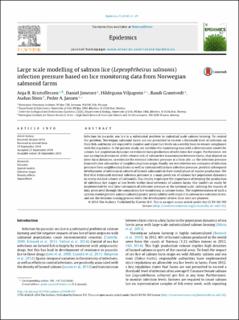| dc.contributor.author | Kristoffersen, Anja Bråthen | |
| dc.contributor.author | Jimenez, Daniel Delgado | |
| dc.contributor.author | Viljugrein, Hildegunn | |
| dc.contributor.author | Grøntvedt, Randi | |
| dc.contributor.author | Stien, Audun | |
| dc.contributor.author | Jansen, Peder A | |
| dc.coverage.spatial | Norway | en_US |
| dc.date.accessioned | 2014-10-23T13:03:47Z | |
| dc.date.accessioned | 2023-03-10T11:44:57Z | |
| dc.date.available | 2014-10-23T13:03:47Z | |
| dc.date.available | 2023-03-10T11:44:57Z | |
| dc.date.issued | 2014 | |
| dc.identifier.citation | Epidemics 2014, 9:31-39 | en_US |
| dc.identifier.issn | 1755-4365 | |
| dc.identifier.uri | https://hdl.handle.net/11250/3057673 | |
| dc.description.abstract | Infection by parasitic sea lice is a substantial problem in industrial scale salmon farming. To controlthe problem, Norwegian salmonid farms are not permitted to exceed a threshold level of infection ontheir fish, and farms are required to monitor and report lice levels on a weekly basis to ensure compliancewith the regulation. In the present study, we combine the monitoring data with a deterministic model forsalmon lice population dynamics to estimate farm production of infectious lice stages. Furthermore, weuse an empirical estimate of the relative risk of salmon lice transmission between farms, that depend oninter-farm distances, to estimate the external infection pressure at a farm site, i.e. the infection pressurefrom infective salmon lice of neighbouring farm origin. Finally, we test whether our estimates of infectionpressure from neighbouring farms as well as internal within farm infection pressure, predicts subsequentdevelopment of infection in cohorts of farmed salmonids in their initial phase of marine production. Wefind that estimated external infection pressure is a main predictor of salmon lice population dynamicsin newly stocked cohorts of salmonids. Our results emphasize the importance of keeping the productionof infectious lice stages at low levels within local networks of salmon farms. Our model can easily beimplemented for real time estimation of infection pressure at the national scale, utilizing the masses ofdata generated through the compulsory lice monitoring in salmon farms. The implementation of such asystem should give the salmon industry greater predictability with respect to salmon lice infection levels,and aid the decision making process when the development of new farm sites are planned.© 2014 The Authors. Published by Elsevier B.V. This is an open access article under the CC BY-NC-NDlicense (http://creativecommons.org/licenses/by-nc-nd/3.0/).
Parasites, Spatial models, Infective stages, Density effects, Aquaculture | en_US |
| dc.language.iso | eng | en_US |
| dc.subject | Parasites | en_US |
| dc.subject | Spatial models | en_US |
| dc.subject | Infective stages | en_US |
| dc.subject | Density effects | en_US |
| dc.subject | Aquaculture | en_US |
| dc.title | Large scale modelling of salmon lice (Lepeophtheirus salmonis)infection pressure based on lice monitoring data from Norwegian salmonid farms | en_US |
| dc.type | Peer reviewed | en_US |
| dc.type | Journal article | |
| dc.date.updated | 2014-10-23T13:03:47Z | |
| dc.rights.holder | © 2014 The Authors | en_US |
| dc.subject.nsi | VDP::Medisinske Fag: 700::Basale medisinske, odontologiske og veterinærmedisinske fag: 710 | en_US |
| dc.source.pagenumber | 31-39 | en_US |
| dc.source.volume | 9 | en_US |
| dc.source.journal | Epidemics | en_US |
| dc.identifier.doi | 10.1016/j.epidem.2014.09.007 | |
| dc.identifier.cristin | 1166550 | |
| dc.relation.project | Norges forskningsråd: 199778 | en_US |
| dc.relation.project | Andre: The Fishery and Aquaculture Industry Research Fund, Norway | en_US |
